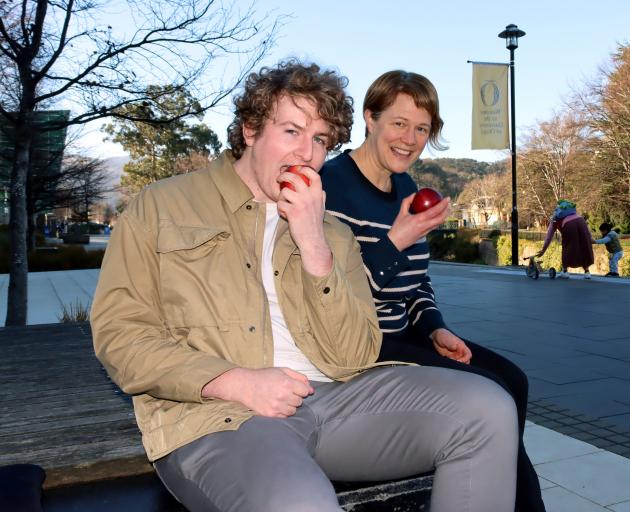Science
Research Unveils Secrets of 300 Heritage Apple Varieties

A comprehensive study of over 300 heritage apple varieties at the Jim Dunckley Heritage Orchard is underway, led by Aaron Hewson, a master of science student in plant biotechnology. This orchard, established 25 years ago by the Coastal Otago Branch of the New Zealand Tree Crops Association, is recognized as one of New Zealand’s most diverse collections of apple cultivars. The project aims to preserve and propagate these heritage varieties through precise genetic identification.
Hewson’s research focuses on identifying these cultivars with confidence, utilizing genetic means to ensure accurate classification. The collection, gathered in the 1990s by Jim Dunckley, includes varieties with unique names like Peasgood Nonsuch, Nonnetit Bastard, Warner’s King, and Albany Beauty. Many of these apples originated from Clyde, where Dunckley collected samples from an old Plant & Food Research orchard.
The naming conventions of some apple trees reflect local geography, with names derived from nearby landmarks. However, this has sometimes led to confusion regarding the genetic identity of certain cultivars. “For instance, we found a Plant & Food apple called Granny Smith, the well-known supermarket variety, and one called Lord Lambourne. Genetically, they turned out to be the same,” Hewson explained, highlighting the complexities of apple nomenclature.
To further investigate these varieties, samples were collected by university students and staff from the Plant Biochemistry Lab, freeze-dried, and sent to a laboratory in France for genetic analysis. This work was facilitated by partnerships with Plant & Food Research, now integrated into the Bioeconomy Science Institute. Hewson credited his co-supervisor, Dr. Elena Lopez-Girona, for her expertise and support throughout the research process.
The genetic analysis employs a technique known as SNP chip technology, which examines approximately 50,000 known DNA markers in apple leaves. This method generates a genetic fingerprint, allowing researchers to determine whether two trees belong to the same variety or differ significantly. As biosecurity regulations restrict the import of new apple genetics, the local collection of heritage varieties could be essential for developing disease-resistant traits in future apple breeding.
According to Hewson, there are approximately 10,000 different apple varieties worldwide, yet most commercial varieties stem from a relatively small genetic pool of just six apples. This narrow genetic base poses risks for disease vulnerability and sustainability in apple farming.
Assisting Hewson in this research is Associate Professor Lynnette Brownfield from the University of Otago. She noted the importance of identifying the genetic diversity within the orchard, which could help breeders introduce new genetic material, enhancing disease resistance and expanding breeding options.
The Coastal Otago Branch of the New Zealand Tree Crops Association, which owns the orchard, will decide how to utilize the findings from Hewson’s research. The overarching goal is to assign unique identifiers to all trees within the collection, thereby creating a comprehensive database. This will enable collaboration with apple breeders ranging from home growers to organizations like Plant & Food Research, ultimately facilitating access to valuable genetic material as needed.
As this project progresses, the implications for apple cultivation in New Zealand could be significant, offering a pathway to healthier, more resilient apple varieties that honor the country’s rich horticultural heritage.
-

 World4 months ago
World4 months agoTest Your Knowledge: Take the Herald’s Afternoon Quiz Today
-

 Sports4 months ago
Sports4 months agoPM Faces Backlash from Fans During Netball Trophy Ceremony
-

 Lifestyle4 months ago
Lifestyle4 months agoDunedin Designers Win Top Award at Hokonui Fashion Event
-

 Entertainment4 months ago
Entertainment4 months agoExperience the Excitement of ‘Chief of War’ in Oʻahu
-

 Sports4 months ago
Sports4 months agoLiam Lawson Launches New Era for Racing Bulls with Strong Start
-

 World5 months ago
World5 months agoCoalition Forms to Preserve Māori Wards in Hawke’s Bay
-

 Health4 months ago
Health4 months agoWalking Faster Offers Major Health Benefits for Older Adults
-

 Lifestyle4 months ago
Lifestyle4 months agoDisney Fan Reveals Dress Code Tips for Park Visitors
-

 Politics4 months ago
Politics4 months agoScots Rally with Humor and Music to Protest Trump’s Visit
-

 Top Stories5 months ago
Top Stories5 months agoUK and India Finalize Trade Deal to Boost Economic Ties
-

 Health2 months ago
Health2 months agoRadio Host Jay-Jay Feeney’s Partner Secures Visa to Stay in NZ
-

 World5 months ago
World5 months agoHuntly Begins Water Pipe Flushing to Resolve Brown Water Issue









